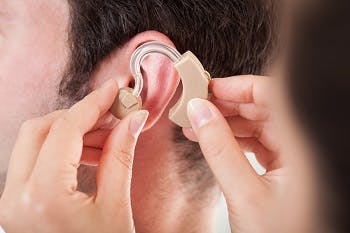
Find out which type of hearing aid will help you get back in the conversation again.
Has an ENT doctor or audiologist determined that you have hearing loss? If so, you may be wondering, “What now?” Well, the next step is to get fitted for a hearing aid.
Of course, with all the advancements in technology there are now so many options when it comes to hearing aids that it can be a bit confusing. Here are some things to consider when shopping for a hearing aid,
The Style
Discretion is usually one of the most important factors that someone mentions when getting a hearing aid (we know being able to hide your hearing aid from others is important). Of course, there are other factors to consider that can help you determine the right style for you. Common hearing aid styles include:
- Invisible-in-the-canal
- Completely-in-the-canal
- In-the-canal
- In-the-ear
- Receiver-in-canal
- Behind-the-ear (often the most versatile hearing aid to accommodate all severities of hearing loss)
Special and Advanced Features
Hearing aids now come with some pretty awesome features and while some may not apply to you or be particularly important for your lifestyle, there are other features that you may wish to have. Top features include:
Noise reduction
This feature separates out dynamic sounds (e.g. television; conversations) from static sounds (e.g. running water) and increases the dynamic sounds while reducing static sounds, making it easier to hear what you actually want to hear.
Directionality
Noisy environments can be a real pain for people with hearing loss. Here’s where the directionality feature on a hearing aid comes in handy. Instead of just “turning up” the volume on all sounds around you, this feature allows you to hear what’s in closer proximity and help you turn your attention and focus on the person in front of you rather than the noisy environment around you. This is particularly helpful for those who work in loud environments such as restaurants.
Multiple channels
Just because a hearing aid has more channels than another doesn’t necessarily mean it’s better. What it means is that these different channels offer ways to adjust different frequencies. Therefore, those dealing with both low-end and high-end pitch problems can adjust the volume on one without necessarily adjusting the volume on another. The idea is that these different channels help even out what a person can hear.
Your Hearing Loss
Of course, the type and severity of your hearing loss will also play a factor in which kind of hearing aid will truly give you the best opportunity to understand those around you. This is something that your otolaryngologist can discuss with you during your evaluation and fitting. There are many options available for those dealing with everything from mild to profound hearing loss.
Are you ready to sit down with an ENT specialist to discuss your hearing aid options? Don’t put off addressing your hearing difficulties. The sooner you treat your hearing loss the better.


